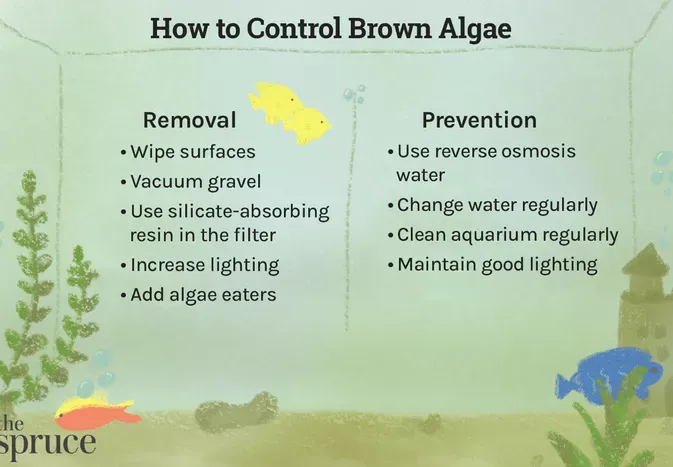How to Remove Brown Algae From Your Aquarium
Updated on 05/27/24

Unveiling the Algae Enigma: A Comprehensive Guide to Eradicating Brown Algae from Your Pristine Aquarium
The allure of a thriving aquarium lies in its vibrant flora and fauna, contrasting against the crystal-clear water. Yet, the idyllic underwater paradise can be marred by the unsightly presence of brown algae. These persistent invaders not only compromise the aesthetic appeal of your aquarium but can also harm its delicate ecosystem.
If you find your aquarium besieged by brown algae, do not despair. This comprehensive guide will arm you with the knowledge and strategies to effectively combat these unwelcome guests, restoring the pristine beauty of your underwater haven.
Understanding Brown Algae: The Culprit Unmasked
Brown algae, scientifically known as diatoms, are microscopic algae that form colonies, often appearing as a brown or greenish-brown film on aquarium surfaces. They thrive in nutrient-rich environments, particularly when there is an excess of silicates or nitrates.
The Root Causes: Identifying the Triggers
Understanding the underlying causes of brown algae growth is crucial for successful eradication. Key factors to consider include:
* Excessive Lighting: Overexposure to bright or prolonged lighting can stimulate diatom proliferation.
* Nutrient Imbalance: High levels of silicates or nitrates in the water column provide ample nourishment for brown algae to flourish.
* Inadequate Water Circulation: Poor water flow allows nutrients to accumulate, creating an ideal environment for algae growth.
* Overcrowding: An excessive number of fish or plants can lead to increased waste production, fueling algae blooms.
* Organic Debris: Decaying plant matter, uneaten food, or fish waste provide nutrients for algae growth.
Combating Brown Algae: A Multi-Faceted Approach
Eradicating brown algae requires a multifaceted approach, targeting both immediate removal and prevention of future outbreaks.
1. Physical Removal: Getting Hands-On
* Manual Cleaning: Use a soft sponge or brush to gently scrub the affected surfaces, removing the algae film. Avoid using abrasive materials that may damage the aquarium.
* Algae Magnets: These tools allow for easy removal of algae from glass surfaces without disrupting the water.
* UV Sterilization: Ultraviolet light can kill algae cells, reducing their population.
2. Nutrient Management: Curbing the Food Source
* Water Changes: Regular water changes help dilute nutrients and reduce their availability for algae growth. Aim for weekly changes of 10-25% of the water volume.
* Silicate Removal: Use activated carbon filters to absorb silicates, a primary nutrient for diatoms.
* Nitrate Reduction: Perform water changes and use nitrate-removing resins or live plants that absorb nitrates.
3. Environmental Optimization: Creating an Unfavorable Environment
* Reduce Lighting: Limit the duration and intensity of lighting to discourage algae growth.
* Enhance Water Circulation: Improve water flow by adding additional powerheads or filters.
* Control Overcrowding: Maintain an appropriate fish load and avoid overcrowding the aquarium.
* Keep It Clean: Regularly remove decaying plant matter, uneaten food, and fish waste to minimize nutrient accumulation.
Preventive Measures: Shielding Your Aquarium from Future Invasions
Once you have successfully eradicated brown algae, it is essential to adopt preventive measures to prevent future outbreaks.
* Regular Maintenance: Continue with regular water changes, nutrient management, and environmental optimization practices.
* Plant Care: Healthy plants compete with algae for nutrients and oxygen, helping to maintain a balanced ecosystem.
* Proper Feeding: Avoid overfeeding your fish to prevent excess nutrients from accumulating in the water.
* Quarantine New Additions: Introducing new plants or fish into your aquarium can inadvertently bring in algae spores. Quarantine them before adding to the main tank.
Examples Unlocking the Power of Solutions
Example 1: Nutrient Management in Action
In a newly established aquarium, high nitrate levels had fueled a persistent brown algae bloom. By implementing regular water changes and adding nitrate-removing resins, the nitrate levels were reduced, and the algae growth was noticeably diminished within two weeks.
Example 2: Environmental Optimization and Physical Removal
An overcrowded aquarium with poor water circulation had become overrun with brown algae. Increasing the water flow with an additional powerhead, combined with manual cleaning using an algae magnet, effectively removed the algae film and created an unfavorable environment for its recurrence.
Conclusion: Restoring Pristine Beauty and Harmony
Battling brown algae can be a daunting task, but with the knowledge and strategies outlined in this comprehensive guide, you can effectively eradicate these unsightly invaders and restore the pristine beauty and harmony of your aquarium. Remember, regular maintenance, nutrient management, and environmental optimization are the cornerstones of prevention, ensuring the continued health and vibrancy of your underwater paradise.
Explore More Pets

Freshwater Aquarium Filters
How to Deal With Cloudy Aquarium Water

Saltwater Aquarium Filters
How Do You Remove Chloramines From Tap Water?

Freshwater Aquariums & Habitat
Can I Keep My Koi Fish Inside?

Saltwater Aquariums & Habitat
14 Best Floating Plants for Your Aquarium

Freshwater Fish Health
How to Treat Ich on Freshwater Fish

Saltwater Fish Health
Fin Rot in Aquarium Fish

Freshwater Aquarium Filters
How to Do Aquarium Water Changes

Saltwater Fish Health
How Do Fish Get Parasites?
